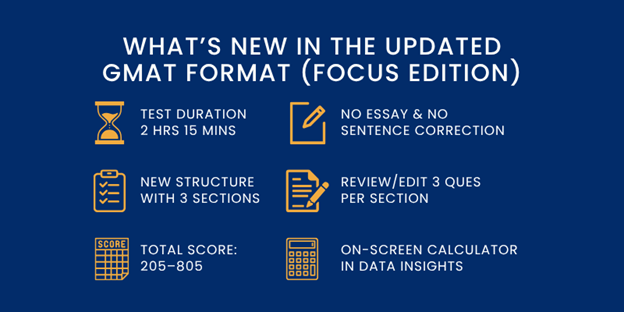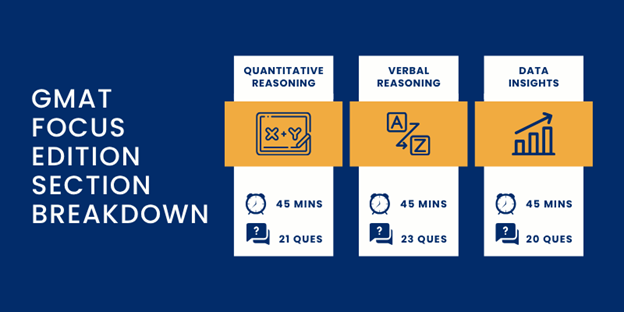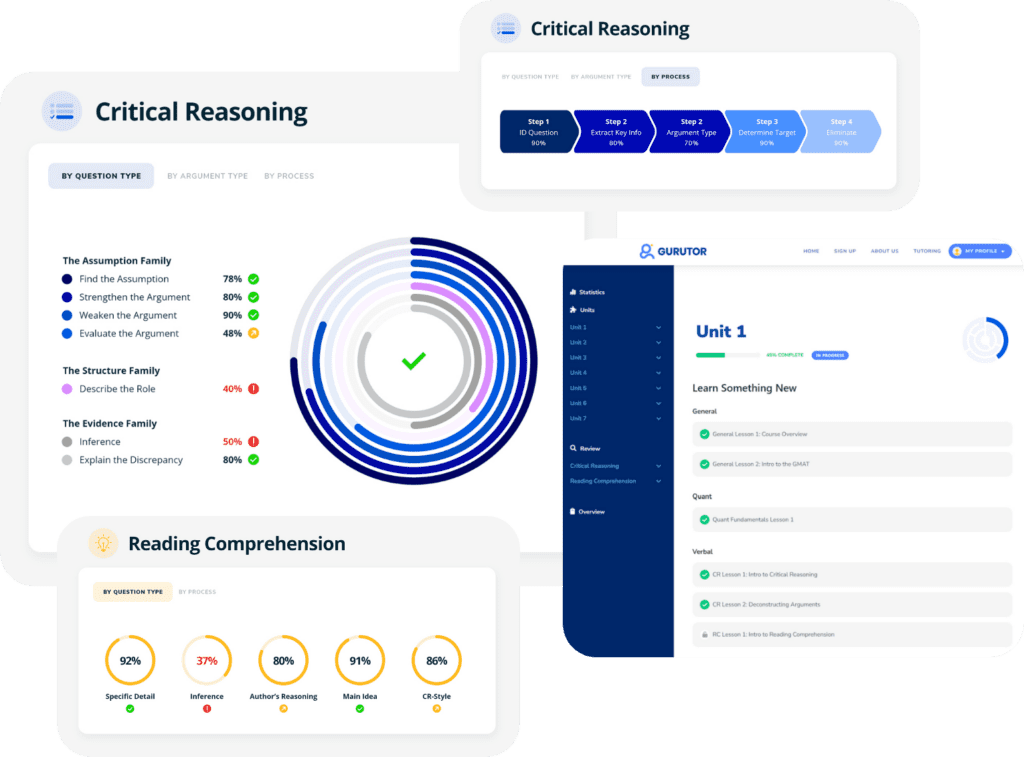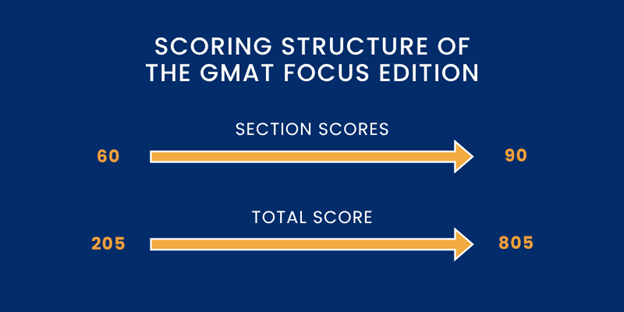What does the GMAT Exam Consist Of?

The GMAT (Graduate Management Admission Test) is the gold standard for business school admissions.
It’s not about memorizing facts; it tests your analytical thinking, problem-solving, and ability to tackle complex problems under pressure.
So, what does the GMAT consist of?
The exam is broken into three focused GMAT sections: Quantitative Reasoning, Verbal Reasoning, and Data Insights.
Each section targets specific skills, combining to give schools a clear picture of your readiness for an MBA or master’s program.
Therefore, understanding what each part covers helps you prepare smarter and perform your best on test day.
Overview of the GMAT Exam Structure
The latest Focus Edition GMAT format is efficient: just 2 hours and 15 minutes of testing time (plus one optional 10-minute break) split into three focused 45-minute sections, and consists of 64 questions in total:
- Quantitative Reasoning: 21 questions, 45 minutes
- Verbal Reasoning: 23 questions, 45 minutes
- Data Insights: 20 questions, 45 minutes
Together, these sections measure exactly what matters: your readiness to succeed in a top MBA or master’s program.
GMAT Focus Edition: What’s New in the Updated Test Format

The GMAT Focus Edition launched on February 1, 2024, replacing the previous 10th Edition.
Redesigned with input from top business schools, it focuses on the skills that truly matter for MBA success.
Here’s what you need to know:
1. Shorter Duration
The test is now just 2 hours and 15 minutes, down from over 3 hours. Instead of 80 questions, you’ll face 64.
2. Changes in the Structure
The four old sections are gone. Now there are three equally weighted sections:
- Quantitative
- Verbal
- Data Insights (replacing integrated reasoning)
3. Scoring Changes
The total score now tops out at 805 (previously 800). Section scores range from 60 to 90.
4. Key Content Updates
No more Analytical Writing Assessment (essay). Sentence Correction questions dropped from Verbal.
Also, data Insights replaces Integrated Reasoning and counts toward your total score.
5. Test-Taker Friendly Features
Choose the order in which you take the three sections, and use the on-screen GMAT calculator in Data Insights. Also, review and edit up to three flagged questions after each section.
These changes make the GMAT Focus Edition more closely aligned with real-world business skills, providing a more effective way to show your readiness for top programs.
Detailed Breakdown of GMAT Sections

The GMAT Focus Edition consists of three main sections: Quantitative Reasoning, Verbal Reasoning, and Data Analysis.
Here’s the GMAT sections breakdown for each:
- Quantitative Reasoning checks how well you can solve problems using basic math and logic.
- Verbal Reasoning tests how well you understand written English, analyze arguments, and read closely.
- Data Insights examines how you handle data, such as charts, tables, and text, and draws conclusions from it.
Each section is scored on its own. You’ll get a score between 205 and 805 for each one. These scores are combined to give your total GMAT score.
1. Quantitative Reasoning
- Number of Questions: 21
- Time Limit: 45 minutes
- Topics Covered: Arithmetic, algebra, and word problems
- Calculator Allowed: No
GMAT Quantitative section tests your ability to solve problems using basic high-school math. All questions are problem-solving types, with no tricky tricks; just logic, math, and reasoning.
The focus is on how you think, not how much math you’ve memorized. You’ll have approximately 2.1 minutes per question, so working quickly and accurately is crucial.
Pro Tip: You can use the new Review/Edit feature to flag up to 3 questions and come back to them later if you have time.
2. Verbal Reasoning
- Number of questions: 23
- Time Limit: 45 minutes
- Types: Reading Comprehension & Critical Reasoning (No Sentence Correction in the Focus Edition)
This section tests how well you understand complex written texts and analyze arguments.
You’ll read passages and answer questions about the main ideas, details, or inferences. You’ll also evaluate short arguments, deciding how to strengthen, weaken, or explain the logic.
Everything is multiple-choice, and you’ll need to work quickly and think clearly under pressure.
3. Data Insights (Focus Edition)
- Number of questions: 20
- Time Limit: 45 minutes
- Question Types: Data Sufficiency, Multi-Source Reasoning, Table Analysis, Graphics Interpretation, and Two-Part Analysis.
- Calculator Allowed: Yes, on-screen calculator available.
This section tests how well you understand and work with data from different sources, like charts, graphs, tables, and short texts.
You’ll need to analyze, compare, and draw conclusions from complex information, just like in real business situations.
With multi-part problems and multiple formats, it’s about thinking clearly and making smart decisions under time pressure.
Section Order and Optional Breaks
The GMAT test structure gives you more control over your test experience.
You can choose the order of the three sections, so you can start with your strongest area or get your weakest section out of the way early.
You also get one optional 10-minute break, which you can take after either the first or second section. Many students plan this strategically, for example, tackling their toughest section first, then taking a break to reset before continuing.
Another helpful feature: after each section, you’ll see a review screen where you can go back and change up to 3 answers, as long as you flagged them earlier.
Just remember: you still need to answer each question in order during the section (no skipping ahead).
The result? A more flexible, test-taker-friendly experience, designed to support your performance, not get in the way of it.
Time Management Tips Per Section
Time is one of your biggest challenges on the GMAT, and smart pacing is key.
Each section gives you 45 minutes, so here’s how it breaks down:
- Quant: 2.1 minutes per question (21 questions)
- Verbal: 1.96 minutes per question (23 questions)
- Data Insights: 2.25 minutes per question (20 questions)
To stay on track:
- Don’t spend too long on any one question; every question counts.
- Eliminate wrong answers, make your best choice, and move on.
- You can mark up to 3 per section to review at the end, so don’t get stuck.
- Use a timed drill, try solving Quant and Verbal problems in under 2 minutes to build speed.
- If you’re testing online, knowing where everything is can save valuable seconds.
The goal isn’t to rush; it’s to stay in control.
This is exactly where Gurutor makes the difference. You don’t just get content; you get GMAT coaching on how to manage your time, make informed decisions under pressure, and finish with confidence.
Every practice session trains your pacing, your instincts, and your GMAT strategy, so test day feels like just another rep.

Scoring Structure of the GMAT Focus Edition
Your GMAT score isn’t just a number; it’s your first impression in a competitive admissions pool.
Thus, understanding your score is the first step toward using it strategically.

Here’s an overview of the GMAT Focus Edition Score:
- Total Score Range: 205 to 805
- Section Scores: Each section (Quant, Verbal, Data Insights) is scored from 60 to 90
- All sections are weighted equally; no section counts more than another
Your final score is based on your combined performance across all three sections.
That means there’s no “carryover,” a high score in one area can’t make up for a weak score in another.
To give you a rough comparison: A Focus Edition score of 645 is about the same as a 700 on the old GMAT scale. This places you roughly in the 88th percentile, according to GMAC’s official data.
You’ll receive a detailed Official Score Report after the test that breaks down your performance by section and question type. This helps you identify your strengths and pinpoint areas for improvement, especially if you decide to retake the GMAT.
Sample GMAT Structure Table
Here’s a quick summary of the GMAT Focus Edition structure, showing question counts, time limits, and scoring ranges by section:
| Section | No. of Questions | Time Limit | Score Range (per section) |
| Quantitative Reasoning | 21 | 45 minutes | 60–90 |
| Verbal Reasoning | 23 | 45 minutes | 60–90 |
| Data Insights | 20 | 45 minutes | 60–90 |
| Total (with break) | 64 | 2h15 (plus 10-min break) | 205–805 |
Preparing Based on GMAT Structure
Understanding the GMAT test pattern is key to preparing effectively.
For example, knowing that the GMAT Quant section includes only Problem Solving questions (no Data Sufficiency) means you can focus on arithmetic and algebra without practicing IR-style problems.
Similarly, since the Verbal section no longer has Sentence Correction, you can spend more time on Critical Reasoning.
Familiarizing yourself with the specific GMAT question types in each section helps you build the right skills and pacing.
Try timed practice sets, like a full 45-minute Quant session, to get used to the roughly 2-minute-per-question rhythm.
For Data Insights, focus on multi-source and graphics problems so you can quickly interpret charts and tables.
Using a structured study plan based on the Focus GMAT format is ideal.
For example, Gurutor is a self-paced GMAT prep platform designed to guide you through the most challenging part of GMAT prep: working through problems independently.
It offers structured guidance built from years of real teaching experience, breaking down each unit and tracking your progress, while highlighting mistakes mid-practice.
FAQs about What Does the GMAT Consist of
How many sections are on the GMAT Focus Edition?
The GMAT Focus Edition consists of three sections: Quantitative Reasoning, Verbal Reasoning, and Data Analysis, each lasting 45 minutes.
What is the GMAT Focus Edition?
Launched in February 2024, the GMAT Focus Edition is the newest version of the exam. It’s shorter and streamlined, with three sections totaling about 2 hours and 15 minutes. Unlike the old format, it no longer includes an essay or a separate Integrated Reasoning section, and it uses a new scoring scale from 205 to 805.
What is the Data Insights section?
Data Insights replaces the old Integrated Reasoning section. It includes 20 questions in 45 minutes that test your ability to analyze and interpret data from charts, tables, and passages. You can use an onscreen calculator here. Question types cover data sufficiency, multi-source reasoning, table analysis, graphics interpretation, and two-part analysis.
